
Membrane vs Mechanical vs Optical Switches Which Keyboard Is Right for You in 2025
Membrane vs Mechanical vs Optical Switches Which Keyboard Is Right for You in 2025
Membrane vs Mechanical vs Optical Switches Which Keyboard Is Right for You in 2025
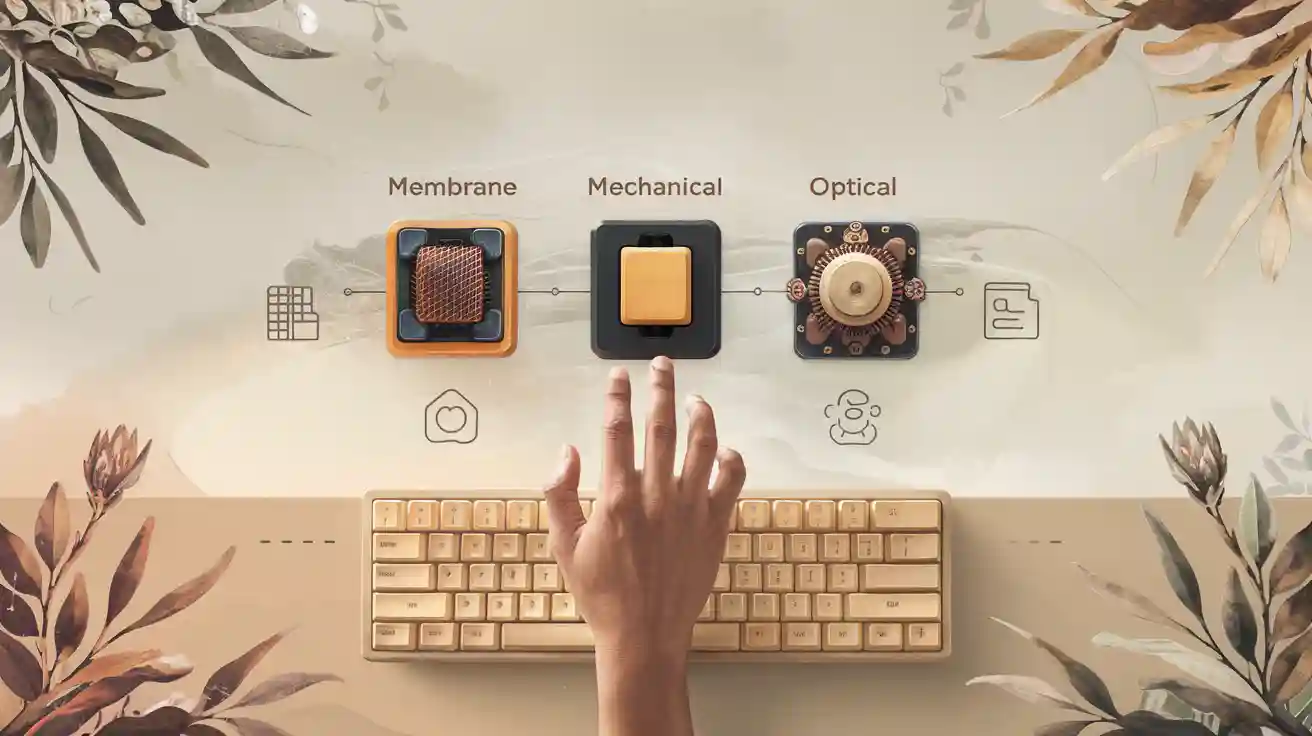
Gamers in 2025 prefer mechanical keyboards for their feel and quick response. Typists choose them because they are comfortable and easy to type on. People looking to save money often opt for switch type membrane keyboards. They appreciate that these are affordable and resistant to spills. The table below shows how satisfied each group is with their choice. This helps readers find the best keyboard for their needs. This new guide helps you choose a keyboard switch with confidence.
Key Takeaways
- Mechanical switches give strong feedback and quick response. They last a long time. They are great for gamers and people who type a lot. These switches help you type fast and feel comfortable.
- Optical switches use light to work very fast. They last a long time too. They are good for gamers and tech users who want speed. These switches are also quiet when you use them.
- Membrane switches are quiet and cost less money. They are good for offices or people who want to save money. They feel softer and do not last as long as other switches.
- Pick your keyboard switch by what you need. Choose speed and feedback for gaming. Pick quiet and comfort for office work. Choose low cost for general use.
- Try out keyboards in person if you can. Think about noise, feel, and price. This helps you find the best switch for your style and daily work.
Quick Comparison
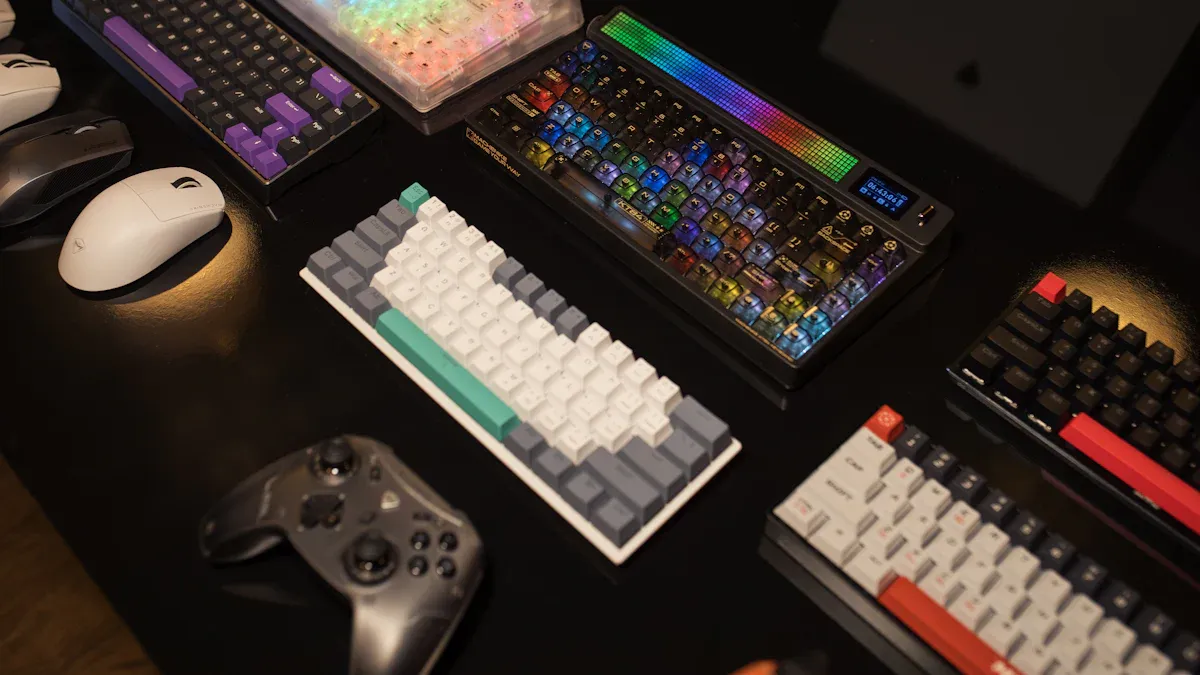
Key Differences
Picking the best keyboard switch depends on what you need. Mechanical switches give a strong feel and make a clicking sound. Many people like that they can pick from tactile, linear, or clicky types. Optical switches use light to work, so they are faster and last longer. They feel smooth but not as bumpy. The switch type membrane is soft and quiet. It is good for people who want a silent and cheap keyboard.
Noise is important if you share your space. Mechanical switches can be noisy, especially the clicky ones. Optical switches are quieter but not totally silent. The switch type membrane is the quietest, so it is great for offices or using at night. How long a keyboard lasts is different too. Mechanical and optical switches can last up to 100 million presses. The switch type membrane does not last as long.
Price is also a big difference. Mechanical switches cost more than membrane but less than optical. Optical switches are the priciest because of their new tech. The switch type membrane is the cheapest choice.
Tip: Gamers like mechanical or optical switches for speed and accuracy. Office workers and people who want to save money pick the switch type membrane for its quiet sound and low price.
Summary Table
Here is a table to help you compare the main features of each switch type:
| Aspect | Mechanical Switches | Optical Switches | Membrane Switches |
|---|---|---|---|
| Feel | Strong tactile feedback, clicky or smooth | Smooth, less tactile | Soft, less tactile |
| Speed | Fast, ~2ms response | Very fast, as low as 0.2ms | Slower |
| Durability | 50-100 million keystrokes | Up to 100 million keystrokes | Less durable |
| Noise | Loud (clicky), quieter (linear) | Quieter than clicky mechanical | Quietest |
| Price | Mid-range | Highest | Lowest |
| Best Use | Gaming, typing, customization | Competitive gaming, speed-focused tasks | Office, general use, budget buyers |
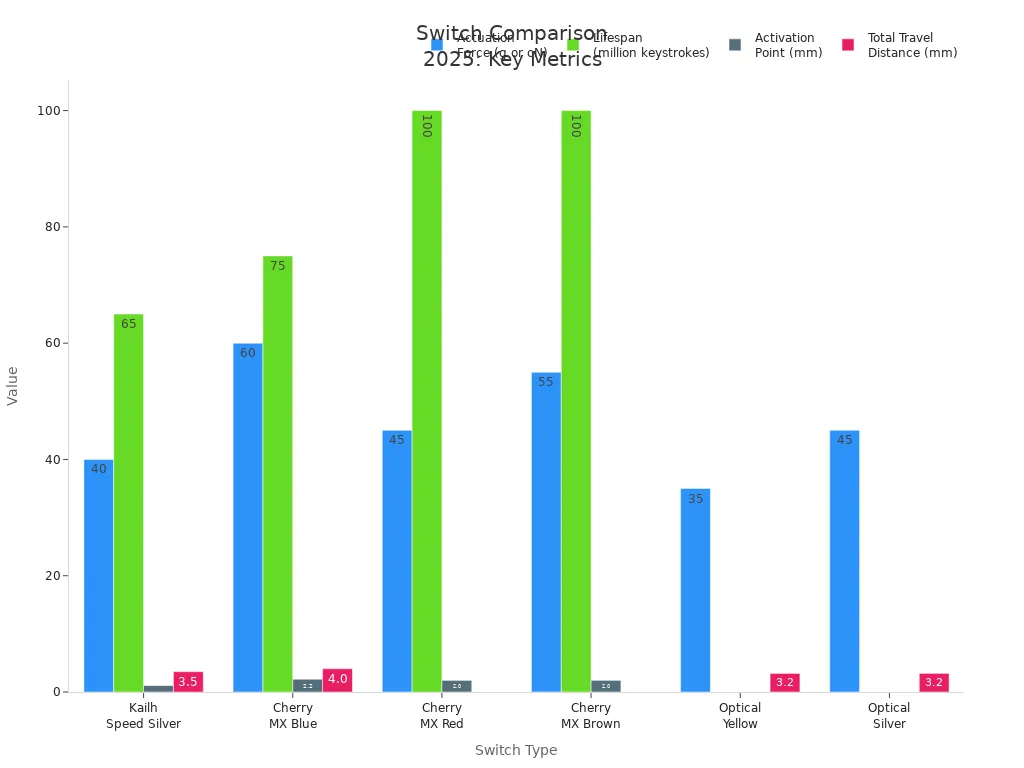
Membrane Switches
How They Work
Membrane switches are made with layers. There are thin sheets stacked together. The top sheet is strong and shows the key labels. This layer keeps the switch safe. Under it, there is a circuit with metal domes. A spacer keeps the layers apart. When you press a key, the top bends down. It touches the circuit below and sends a signal. Some switches use a metal dome that flattens to connect. The switch type membrane uses ribbon connectors. These make it easy to add to many devices.
Benefits
- Works well for many touch screens and buttons
- Dome-switch types give better feedback when pressed
- Small and thin, so it fits in modern gadgets
- Strong materials help it last longer
- Good for the planet because parts can be recycled
- Cheap to make in big amounts
- Can meet tough rules for different jobs
- Can have cool features like haptic feedback and multi-touch
Note: The switch type membrane keeps getting better. New materials and features make it good for home and work.
Drawbacks
The switch type membrane does not last as long as others. It feels softer and gives less feedback. Keys may stop working well after a while. Fixing it is hard because the layers are sealed. Some people do not like typing on it for a long time.
Who Should Use
Membrane switches are good for people who want quiet and cheap keyboards. They are great for offices, schools, and homes. Many electronics, car dashboards, and medical tools use them. Companies in Hungary and Europe like them for saving money and easy changes.
Switch Type Membrane
The switch type membrane is still liked in 2025. More people use it in electronics and cars. You can make it in many shapes and colors. It can have backlights too. As more things need quiet and strong buttons, the switch type membrane is a smart pick for many jobs.
Mechanical Switches
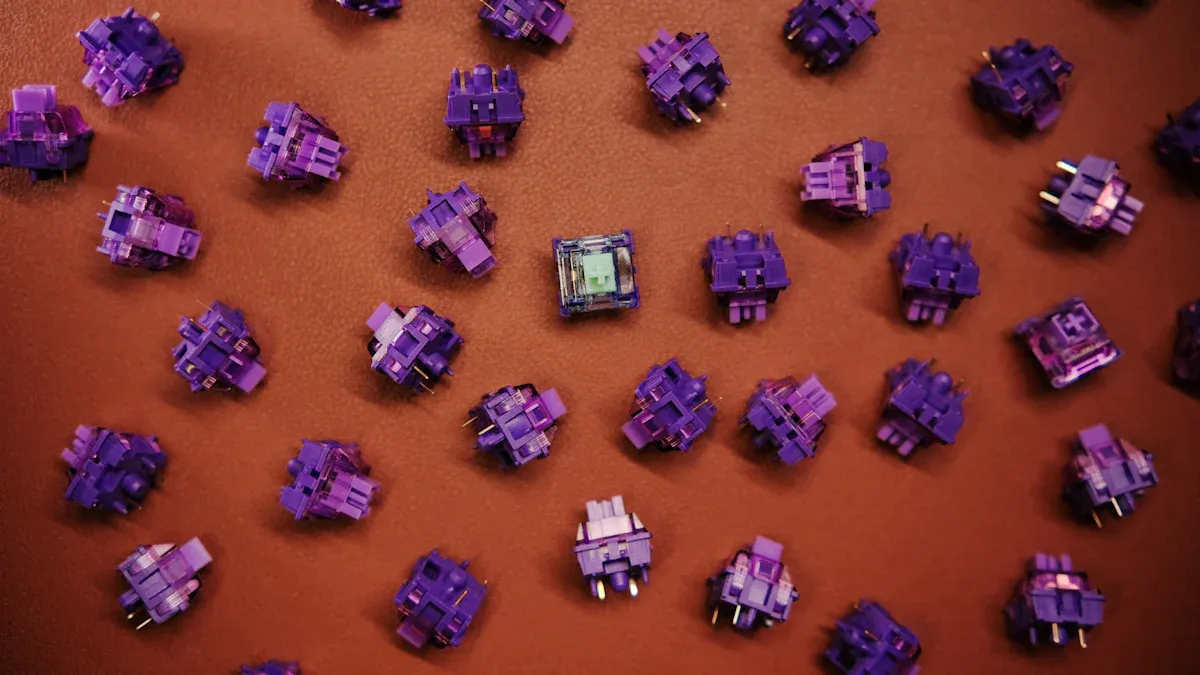
How They Work
Mechanical switches work by moving real parts. When you press a key, a metal piece moves. This connects two spots in the circuit. The computer gets a signal from this. Each switch works on its own. This gives each key a special feel and sound. There are many types like linear, tactile, and clicky. Each one feels different when you use it. Some switches have one or two poles. Some use gold on the contacts for better signals. The table below shows some common types and what they do:
| Switch Type | Typical Use Case | Contact Material / Feature |
|---|---|---|
| SPDT | Used for many things, relay control | Normal contacts, very reliable |
| DPDT | Controls two things at once | Good for two signals together |
| Gold Plated SPDT | Good for low power, steady signal | Gold on the contacts |
Benefits
- Mechanical switches give strong feedback and a clear click. You can feel and hear every key you press.
- They last longer than membrane switches. Some can last up to 100 million presses.
- Many people like to change their keyboards. You can pick different switches and keycaps.
- These switches work well in tough places like factories or cars.
- Gamers and people who type a lot like how fast and steady they are. They help you type faster and make fewer mistakes.
- There are many choices, so you can find what you like best.
Note: People in Hungary and Europe still like mechanical switches. They trust them and like to make them their own.
Drawbacks
Mechanical switches can be loud, especially the clicky ones. Some people do not like the noise in quiet rooms. These keyboards cost more than membrane ones. They are heavier and taller, so not easy to carry. Cleaning them is harder because dust can get inside. Some people get tired hands from the strong feedback after a long time.
Who Should Use
Mechanical switches are good for people who want the best typing or gaming. Gamers like them for fast and accurate play. Typists like the comfort and feedback. People in factories use them because they last long and need little care. Home users who want to change their keyboard and keep it for years also like them. The table below shows who gets the most from these switches:
| User Type | Key Preferences and Needs | Application Context and Benefits |
|---|---|---|
| Gamers | Fast keys, accuracy, good feedback | Gaming, e-sports, faster reactions |
| Typists | Comfort, less mistakes, good feel | Office work, writing, data entry |
| Industrial | Strong, lasts long, needs little care | Machine control, tough places |
| Home Users | Can change parts, lasts a long time | Everyday use, personal choice |
Optical Switches
How They Work
Optical switches use light to know when you press a key. When you push a key, it lets a light beam pass through. The keyboard sees this and tells the computer. Companies make these switches in different ways:
- Some switches move tiny mirrors or prisms. This changes where the light goes.
- MEMS switches have small mirrors on chips. These mirrors tilt to move the light beam.
- Some designs use liquids. When you add power, the liquid moves and bends the light.
- Other switches change how light moves using heat or magnets.
These ways help optical switches work fast and last a long time.
Benefits
Optical switches have many good points in 2025:
- They react very fast, so they are great for games.
- They last a long time, up to 100 million presses.
- They use less power and do not get hot. This helps in big computer rooms and smart gadgets.
- They send data quickly with little delay. This is good for cloud work and 5G.
- They are small and fit thin keyboards. They also let you use cool new features.
Tip: Optical switches help new tech like AI and smart cities work better.
Drawbacks
| Limitation | Explanation |
|---|---|
| Limited Customization | Not many switch types or keycaps, so less personal style. |
| Compatibility Issues | Only some keyboards use optical switches, so you have fewer choices. |
| Light Interference | Bright lights can mess up how the switches work. |
Some people want more ways to change their keyboards. Not all keycaps fit, and only some keyboards use these switches. Bright lights can also make them work less well.
Who Should Use
Optical switches are good for people who need fast and steady keys. Gamers like them because they are quick and do not lag. People who work with cloud computers or smart gadgets also like them. These switches are nice for quiet offices and last a long time. If you want the newest tech, optical switches are a smart pick.
Head-to-Head
Feel
Mechanical keyboards give the strongest feedback. Each key feels different when you press it. You might feel a bump or hear a click. Many people like this, especially if they type or play games a lot. Optical switches feel smoother than membrane switches. They are not as bumpy as mechanical ones. The switch type membrane feels the softest. These keys feel squishy and need more force. This can make typing slower.
| Keyboard Type | Tactile Feedback | Typing Experience Description | User Preference / Use Case |
|---|---|---|---|
| Mechanical | Strong feedback with bumps or clicks | Fun and quick to type on; you can change how keys work and look; many pros like them for how well they work | Pros and gamers like them for being fast and exact |
| Membrane | Not much feedback; needs more force | Soft and squishy feel; not as quick; can slow you down and make mistakes | Good for people who want cheap and simple keyboards |
| Optical (Scissor Frame) | Some feedback; better than membrane, less than mechanical | Keys feel steadier and better than membrane; thin design; not many ways to change them | Good for people who want something in the middle, often in laptops |
In 2025, studies show pros and gamers like mechanical keyboards best. They like how exact and quick they feel. Membrane keyboards are good for people who want soft keys. Optical switches are good for those who want both comfort and speed.
Speed
Mechanical and optical switches are both fast. Mechanical switches notice your key press quickly. This helps in games and fast typing. Optical switches use light, so they are even faster. Some can react in just 0.2 milliseconds. The switch type membrane is slower. It needs more force and takes longer to send the signal. Gamers and fast typists see this difference the most.
Tip: Optical switches are the fastest in 2025. Mechanical switches are next. Membrane switches are the slowest.
Durability
Mechanical and optical keyboards last a long time. Many can handle up to 100 million presses. This is good for people who use their keyboard a lot. Mechanical switches use strong parts for each key. Optical switches do not touch inside, so they wear out less. The switch type membrane does not last as long. Its layers can break, and keys may stop working after lots of use. Most membrane keyboards last a few million presses.
- Mechanical: 50-100 million presses
- Optical: Up to 100 million presses
- Membrane: Less than 10 million presses
Noise
Mechanical keyboards can be loud, especially the clicky ones. The sound comes from the moving parts inside. Some people like the noise, but it can bother others. Optical switches are quieter than mechanical, but not silent. The switch type membrane is the quietest. The soft layers soak up sound. This makes them good for offices, libraries, or using at night.
Note: If you need a quiet keyboard, membrane is best.
Price
Mechanical and optical keyboards cost more than membrane ones. Mechanical keyboards start at about €60 and can go over €500. Optical keyboards usually cost even more, with top ones over €200. The switch type membrane is the cheapest. Most cost much less than the other types. This makes them popular for schools, offices, and people who want to save money.
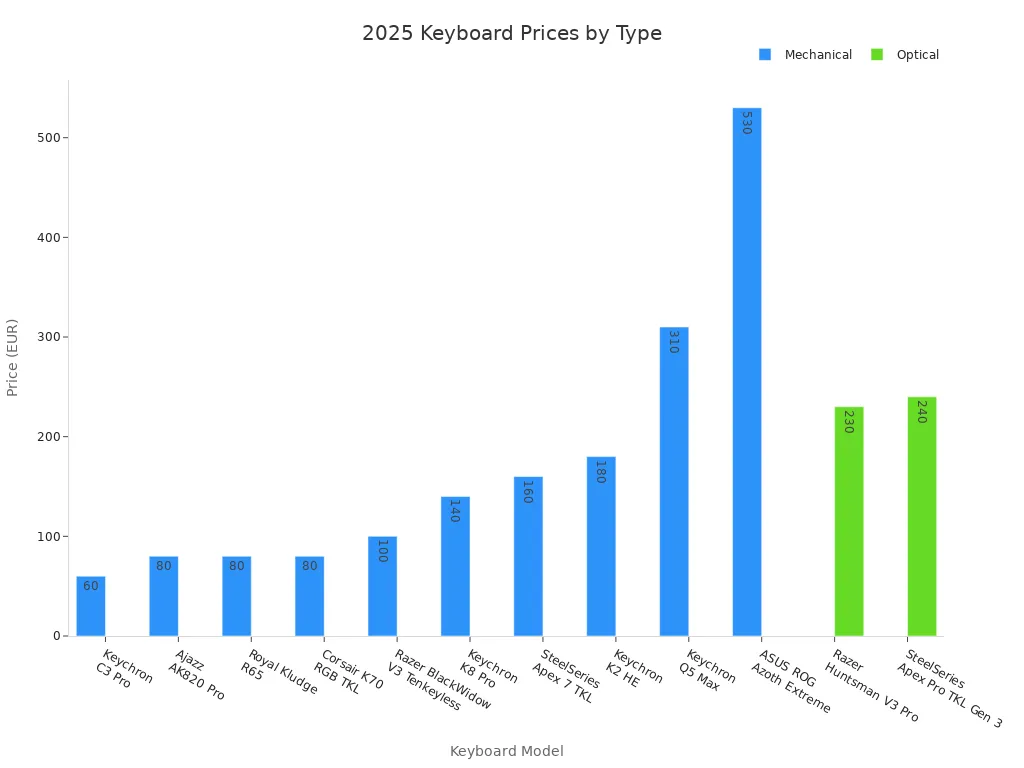
| Keyboard Type | Example Model | Price Range (EUR) |
|---|---|---|
| Mechanical | Keychron C3 Pro | ~60 |
| Mechanical | SteelSeries Apex 7 TKL | ~160 |
| Mechanical | ASUS ROG Azoth Extreme | ~530 |
| Optical | Razer Huntsman V3 Pro | ~230 |
| Optical | SteelSeries Apex Pro TKL Gen 3 | ~240 |
| Membrane | Generic Office Model | ~10-30 |
Mechanical and optical keyboards have more features and last longer. The switch type membrane is best for saving money.
Best for You
Gaming
Gamers in 2025 want fast, accurate, and comfy keyboards. Most pro esports players pick linear switches because they are quick and easy to press. Cherry MX Speed Silver and SteelSeries OmniPoint Adjustable switches are top picks. These switches help players react fast in games. The table below shows why these switches are liked:
| Switch Type | Key Features & Specs | Pros | Cons |
|---|---|---|---|
| Cherry MX Speed Silver | Linear, 45g actuation force, 1.2mm actuation distance, quiet, durable (100M strokes) | Fast actuation, smooth, consistent, durable | Light touch, no tactile feedback |
| SteelSeries OmniPoint Adj. | Linear, 45g actuation force, adjustable actuation point (0.2-3.8mm), quiet | Highly customizable, fast response, durable | Expensive, software dependent |
Most esports players like linear switches such as Cherry MX Speed Silver for their speed. Some use tactile switches for feedback, but speed is most important in gaming. Gamers should pick keyboards with fast actuation, low lag, and strong build. Optical switches are also very fast, so they are good for serious gaming.
Tip: For top gaming, get a keyboard with linear switches and a quick actuation point.
Typing
Typing well and feeling good depends on the switch and keyboard shape. Mechanical keyboards with pre-lubed switches, like the Keychron Q5 Max, feel soft and are built well. Low-profile keyboards like the NuPhy Halo96 V2 help your wrists and guide your fingers. Ergonomic keyboards, such as the Logitech Ergo K860, make hands and shoulders less tired. The table below lists top keyboards for typing in 2025:
| Keyboard Model | Switch Type / Features | Typing Efficiency & Comfort Highlights |
|---|---|---|
| Keychron Q5 Max | Mechanical, pre-lubed switches | Cushioned typing, premium build, customizable stabilizers |
| NuPhy Halo96 V2 | Mechanical, low-profile | Wrist comfort, long battery, finger-guiding keycaps |
| Logitech Ergo K860 | Scissor switches, ergonomic | Split layout, reduces strain, natural arm position |
| ROYAL KLUDGE RK61 | Mechanical, hot-swappable option | Compact, wireless, customizable switches |
| Logitech MX Keys | Scissor switches | Comfortable typing, highly rated, alternatives include WhiteFox and Keychron K1/K2 |
Logitech MX Keys is often called comfy for typing. Some people like mechanical switches for their feel, while others like scissor switches because they are quiet. The best keyboard for typing fits your hands and how you type. Ergonomic keyboards help you type longer without getting tired.
Note: Typists should try different keyboards to see which one feels best for their hands and style.
Office
Office workers need keyboards that are quiet, comfy, and work well. Membrane switches are a favorite for shared spaces because they are very quiet. Scissor-switch keyboards, like Logitech MX Keys, are comfy and not loud. Ergonomic keyboards such as Logitech Ergo K860 help stop hand pain during long days. Mechanical keyboards with linear or tactile switches can be good if noise is not a problem.
Key features for office use:
- Quiet keys
- Comfortable to use
- Ergonomic shape
- Reliable every day
For open offices or shared desks, pick a membrane or scissor-switch keyboard. For private offices, mechanical keyboards with soft switches can help you type faster and feel better.
Budget
People who want to save money in 2025 have lots of good choices. Cheap keyboards now have features that used to cost more. MageGee Portable 60% is great for its hot-swappable switches and small size. HyperX Alloy Origins gives strong performance and cool lights for a fair price. Arteck Ergonomic Wired Keyboard is comfy and does not cost much. The table below compares top budget keyboards:
| Keyboard Model | Price | Switch Options (Type) | Key Features & Consumer Feedback |
|---|---|---|---|
| MageGee Portable 60% | $26 | Brown (tactile), Red (linear), Blue (clicky), Blue Whale/Violet/Ivory White (lubricated linear, silent) | Hot-swappable, minimal latency, compact, praised for value, can be loud. Ideal for gamers needing portability and savings. |
| HyperX Alloy Origins | $100 | HyperX Red (linear), HyperX Aqua (tactile), HyperX Blue (clicky) | High performance, RGB lighting, detachable cable, tactile feedback, strong choice for gamers on a budget. |
| Arteck Ergonomic Wired Keyboard | $50 | Low-profile tactile keys (non-mechanical) | Split ergonomic design, tactile feedback, affordable, suitable for users needing ergonomic benefits at a lower price. |
Many people like MageGee Portable 60% because it works well and is cheap. HyperX Alloy Origins has fancy features for a middle price. Arteck Ergonomic Wired Keyboard is good for people who type a lot and want comfort. Buyers should think about what they need most—like size, comfort, or gaming—when picking a budget keyboard.
Tip: Budget keyboards in 2025 are comfy and work well. You do not have to give up quality to save money.
| User Type | Best Switch Type(s) | Key Benefit |
|---|---|---|
| Gamer | Mechanical, Optical | Fast, durable, responsive |
| Typist | Mechanical (tactile) | Comfortable, accurate, satisfying |
| Office Worker | Silent Mechanical | Quiet, smooth, reliable |
| Budget-Conscious | Hybrid, Membrane | Affordable, simple, easy to use |
Everyone should think about how the keyboard feels. Speed, noise, and price matter too. Try out keyboards in a store if you can. Watching expert videos can help you decide. In 2025, people pick keyboards based on what they need. New features also help people choose the best one.

Know the Difference between Tactile and Non-Tactile Membrane Switching
When selecting the appropriate interface for a product, it can be wise to understand the differences between tactile and non-tactile membrane switches so that the engineer and the purchaser make a better decision. They are both very common in medical equipment, domestic appliances, and industrial equipment, though they do not present the same user experience. ...

Step-by-Step Guide to Selecting the Right Membrane Switch for Your Product
It is not easy to choose the appropriate interface for an electronic device with the number of various types of membrane switches. This is a basic, stepwise analysis to help product designers and manufacturers select the optimal choice. Step 1: Determine your Application Requirements Begin by making a list of locations where switches are used, ...

Top Membrane Switches for Home Electronics Projects in 2025
You can elevate your home electronic membrane switch project in 2025 with standout models such as the 4×4 Matrix 12 Keys Keypad from SOUSHINE, the rgb-enabled strip switches from Molex, and custom graphic switches by Panasonic. These switches offer slim profiles and reliable performance, making them easy to integrate into your DIY setup. You gain ...
Contact us online